Friday 3 September 2004
After
breakfast Nikolay meets us again a little after 9. We first go for coffee at
Ideal Cup or Idealnaya Chaska. This is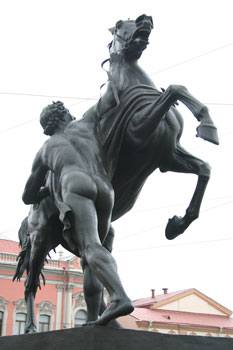 Russia's answer to Starbucks. They have a wide range of delicious coffees and
several branches on Nevsky Prospekt. We take a trolleybus to the Achnikov
bridge. This bridge over the Fontanka river is being "guarded"
by four statues of horses, being tamed by a nude man. The statues are made by
the German sculptor Klodt and symbolise the struggle between man and nature.
Next to the bridge is the
Beloselsky-Belozersky palace. It once belonged
to the Communist party, but now houses a wax museum. We walk along the Fontanka,
with a view on the Achnikov-palace. The palace was once connected by
water through a canal running into the palace itself. It was twice given away as
a present by two empresses to their respective lovers: both Elizabeth and Catharina
the Great did this. We continue, cross through an eclectic housing block and
make our way to the
Vladimir church. It is an early classicist church built from 1761 until 1783
with a separate bell tower by Quarenghi. It is a beautiful church. There is a
separate stall where you can buy candles to burn inside the church. In front of
the entrance is a group of elderly beggars. Entry is free in this church and we
can wander around. There is a service going on. After church we go to the nearby
indoor
Russia's answer to Starbucks. They have a wide range of delicious coffees and
several branches on Nevsky Prospekt. We take a trolleybus to the Achnikov
bridge. This bridge over the Fontanka river is being "guarded"
by four statues of horses, being tamed by a nude man. The statues are made by
the German sculptor Klodt and symbolise the struggle between man and nature.
Next to the bridge is the
Beloselsky-Belozersky palace. It once belonged
to the Communist party, but now houses a wax museum. We walk along the Fontanka,
with a view on the Achnikov-palace. The palace was once connected by
water through a canal running into the palace itself. It was twice given away as
a present by two empresses to their respective lovers: both Elizabeth and Catharina
the Great did this. We continue, cross through an eclectic housing block and
make our way to the
Vladimir church. It is an early classicist church built from 1761 until 1783
with a separate bell tower by Quarenghi. It is a beautiful church. There is a
separate stall where you can buy candles to burn inside the church. In front of
the entrance is a group of elderly beggars. Entry is free in this church and we
can wander around. There is a service going on. After church we go to the nearby
indoor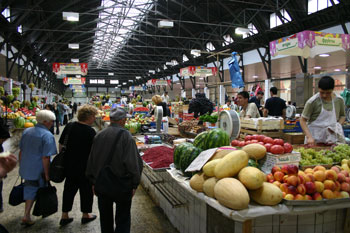 Kuznechny market for vegetables, fruit, meat and fish. It is said to be
the best stocked market in town. We buy some caviar. We walk on and pass a
statue of the writer Dostoevsky and later on a museum dedicated to the same
writer. Dostoevsky lived here from 1878 until his death in 1881. Dostoevsky used
the city as a backdrop for his novels. In this apartment he wrote The
Brothers Karemazov.
Kuznechny market for vegetables, fruit, meat and fish. It is said to be
the best stocked market in town. We buy some caviar. We walk on and pass a
statue of the writer Dostoevsky and later on a museum dedicated to the same
writer. Dostoevsky lived here from 1878 until his death in 1881. Dostoevsky used
the city as a backdrop for his novels. In this apartment he wrote The
Brothers Karemazov.
We
take the metro to Nevsky square. Opposite the Moscow hotel is the Alexander Nevsky
monastery. A working monastery founded by Peter the Great on the spot where
he thought that Alexander had beaten the Swedes in 1240. The grounds can be
visited freely. 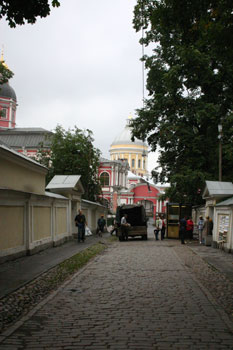 There are also two cemeteries (Tivkhin and Lazarus) with lots of celebrities
like Tsjaikovski,
Mussorgorski, Rimsky-Korsakov en Dostoyevski. For these cemeteries an
entry fee is being charged. In the Trinity Church rest the bones of Alexander
Nevsky himself. Lots of women attend a service here, after which they kneel at
the sarcophagus and touch it. The icons, too, are being kissed. Behind the
church is the Nicholas graveyard, where we can stroll around in all quiet. After
the visit to the monastery we have something to drink and eat at the cafeteria.
Erik orders a Borsht, a Russian vegetable soup.
There are also two cemeteries (Tivkhin and Lazarus) with lots of celebrities
like Tsjaikovski,
Mussorgorski, Rimsky-Korsakov en Dostoyevski. For these cemeteries an
entry fee is being charged. In the Trinity Church rest the bones of Alexander
Nevsky himself. Lots of women attend a service here, after which they kneel at
the sarcophagus and touch it. The icons, too, are being kissed. Behind the
church is the Nicholas graveyard, where we can stroll around in all quiet. After
the visit to the monastery we have something to drink and eat at the cafeteria.
Erik orders a Borsht, a Russian vegetable soup.
We
take the metro back to the hotel and say goodbye to Nikolay. After a break we
have lunch again at the Meat Grinder. After that we pay a second visit to the Hermitage,
where we focus on impressionists and later styles of the 20th century. Many
Monets, Gauguins, four Van Goghs and many others. Quite a few Picasso's too.
Finally we take a brief look at some rooms with Indian and Persian artifacts.
We
walk to the Isaac cathedral, which I climb. For foreigners there is a
separate pay desk with special high prices. This is typical for many museums and
attractions in Russia.
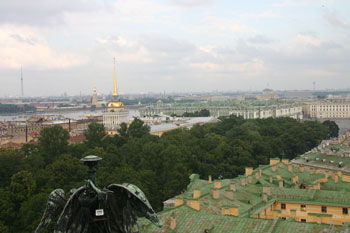 The
price difference can be as much as twenty fold! This one is not so bad though.
For only 100 Ruble (€2,90) you can climb up to the colonnade under the dome.
The view from up there is magnificent. You can see most of the major churches in
the city's skyline. The
price difference can be as much as twenty fold! This one is not so bad though.
For only 100 Ruble (€2,90) you can climb up to the colonnade under the dome.
The view from up there is magnificent. You can see most of the major churches in
the city's skyline.
At
night we have dinner at a restaurant close by (Udachny Vistrel in Gorokhovaya ul.)
a joint with a hunting theme. I have deer, Erik the duck. Later at night we head
for Greshniki or Sinners, a gay club. On 4 floors it offers a dance floor,
lounge bar and pub enlivened by Gogo dancers and a kind of medieval dungeon
theme. Not unfriendly, but not very special either. We meet Niko who is here
with two new customers. We go back to our room around 1 pm
Weather:
cloudy, but warm. Later sunny spells. 23°C/74°F.
Saturday 4
September 2004
Today
we take the Meteor hydrofoil from behind the Hermitage to Petergof or Peterhof
(Peter's Yard) near the village of Petrodvorets, the 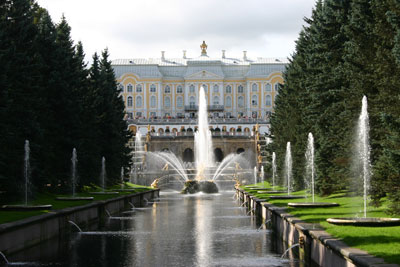 summer
residence of Peter the Great. It is a high speed boat trip of about 40 minutes
through the Gulf of Finland. After debarkation we have to pay entry to enter the
gardens. Petergof is a Russian Versailles with beautiful gardens famous
for the fountains and cascades. Uncontested highlight is the Grand Cascade in
front of the palace with more than 140 fountains and adorned with gilded
statues, mainly of nude men. In the middle is Samson tearing the jaws open of
lion, symbolising the victory on the Swedes. There is an enormous queue for the
palace itself summer
residence of Peter the Great. It is a high speed boat trip of about 40 minutes
through the Gulf of Finland. After debarkation we have to pay entry to enter the
gardens. Petergof is a Russian Versailles with beautiful gardens famous
for the fountains and cascades. Uncontested highlight is the Grand Cascade in
front of the palace with more than 140 fountains and adorned with gilded
statues, mainly of nude men. In the middle is Samson tearing the jaws open of
lion, symbolising the victory on the Swedes. There is an enormous queue for the
palace itself so we leave the interiors for what they are. We stroll through the gardens and
look at the annexes like the Marly (guest house), the Hermitage (diner parlour)
and Monplaisir (study with sea view). The complex is beautifully located at the
waterside. Peter the Great looked for peace and quiet here, but he also knew how
to throw a party. The fountains play from May through September from 11am to
7pm, so it takes a while before we see the fountains in full swing. The gardens
are lovely and after an hour and a half we return to the jetty. It takes a while
before we can board a hydrofoil back to the city. There is a long queue and 3
boats leave before we can board ours. Good thing is that there lots of
hydrofoils going in and out of the marina.
so we leave the interiors for what they are. We stroll through the gardens and
look at the annexes like the Marly (guest house), the Hermitage (diner parlour)
and Monplaisir (study with sea view). The complex is beautifully located at the
waterside. Peter the Great looked for peace and quiet here, but he also knew how
to throw a party. The fountains play from May through September from 11am to
7pm, so it takes a while before we see the fountains in full swing. The gardens
are lovely and after an hour and a half we return to the jetty. It takes a while
before we can board a hydrofoil back to the city. There is a long queue and 3
boats leave before we can board ours. Good thing is that there lots of
hydrofoils going in and out of the marina.
Back in the city we have some lunch at
МАКДОНАЛДС
(MacDonalds). We cross the Dvortsovy bridge and the Berzhevoy bridge over the
river
Neva via the Vasilevsky island towards the Peter & Paul fortress. The
bridges are opened up during summer between about 2am and 5am to allow sea going
ships free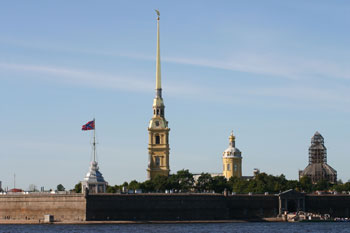 passage. Important to know if you do not want to get stranded on the wrong side
of the bridge at night. Many newly wed couples get their pictures taken against
the backdrop of the fortress. They drink champagne and break the glasses.
Hydrofoils scurry over the water of the River Neva towards Petergof. We continue
towards the fortress. In front of it is a beach where brave St Petersburgers try
to catch every sunray they can get. Inside the fortress we visit the cathedral
with its landmark golden spire. At the central cashier we buy a combination
ticket valid for all the attractions inside the fortress. Inside the cathedral
(Baroque 1712-33) all the Czars since Peter I until the revolution are buried,
except for two. Since 1998 even the last Czar, Nicholas II and his
passage. Important to know if you do not want to get stranded on the wrong side
of the bridge at night. Many newly wed couples get their pictures taken against
the backdrop of the fortress. They drink champagne and break the glasses.
Hydrofoils scurry over the water of the River Neva towards Petergof. We continue
towards the fortress. In front of it is a beach where brave St Petersburgers try
to catch every sunray they can get. Inside the fortress we visit the cathedral
with its landmark golden spire. At the central cashier we buy a combination
ticket valid for all the attractions inside the fortress. Inside the cathedral
(Baroque 1712-33) all the Czars since Peter I until the revolution are buried,
except for two. Since 1998 even the last Czar, Nicholas II and his 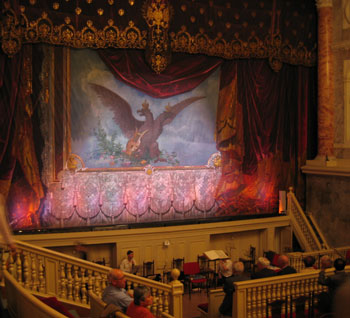 murdered
family found their final resting place here in a separate chapel. We also visit
the prison block where many pre-revolutionary dissidents were incarcerated,
among whom celebrities like Dostoevsky, Tolstoj and the Lenin's elder brother. We
leave the fortress and walk towards the Troitsky bridge. We see St Petersburg's
mosque on Kamenoostrovsy Prospekt. The mosque from 1914 was modeled after
a shrine in Samarkand in Central Asia and looks magnificent with its azure blue
dome and minarets. Entry is difficult, clearly not a tourist attraction. We walk
back via the Troitsky bridge to the city centre and our room . murdered
family found their final resting place here in a separate chapel. We also visit
the prison block where many pre-revolutionary dissidents were incarcerated,
among whom celebrities like Dostoevsky, Tolstoj and the Lenin's elder brother. We
leave the fortress and walk towards the Troitsky bridge. We see St Petersburg's
mosque on Kamenoostrovsy Prospekt. The mosque from 1914 was modeled after
a shrine in Samarkand in Central Asia and looks magnificent with its azure blue
dome and minarets. Entry is difficult, clearly not a tourist attraction. We walk
back via the Troitsky bridge to the city centre and our room .
At
night we walk towards the Hermitage Theater. 8pm the ballet
Giselle
will performed here. It is a small intimate classicist theatre, once the private
theatre of Catherine II. It was built around 1780 by Quarenghi. Beautiful
setting for a nice classical ballet performance, that seems to be visited only
by tourists. Our host John at the B&B was so kind to fix the tickets for us.
After the performance we have some drinks at the James Cook pub, a café and pub
under one roof with (relaxed) live music
Weather:
sunny, but
a cold wind. 18°C/64°F
|